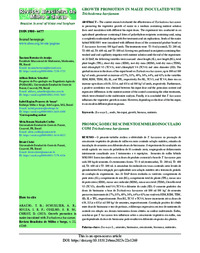Growth promotion in maize inoculated with Trichoderma harzianum.
Growth promotion in maize inoculated with Trichoderma harzianum.
Autoria: ARAÚJO, T. B. de; SCHUELTER, A. R.; SOUZA, I. R. P. de; COELHO, S. R. M.; CHRIST, D.
Resumo: The current research evaluated the effectiveness of Trichoderma harzianum in promoting the vegetative growth of maize in a medium containing nutrient solution from seed inoculation with different bio-input doses. The experiment was conducted in an agricultural greenhouse containing 8 liters of polyethylene recipients containing sand, using a completely randomized design with five treatments and six replications. The maize hybrid MSG1001 seeds were inoculated with different doses of the commercial product based on T. harzianum for every 100 kg of seeds. The treatments were: T1: 0 ml (control), T2: 200 ml, T3: 400 ml, T4: 600 ml, and T5: 800 ml. Sowing was performed in recipients containing fine-washed sand and capillarity irrigation with nutrient solution until the end of the experiment. At 28 DAP, the following variables were assessed: shoot length (SL), root length (RL), total plant length (TPL), shoot dry mass (SDM), root dry mass (RDM), total dry mass (TDM), total chlorophyll V3 (TCV3), total chlorophyll V4 (TCV4) and stem diameter (SD). The gradual increase in the doses of bio-input based on T. harzianum, up to 800 ml 100 kg-1 of seeds, promoted an increase of 27%, 81%, 40%, 34%, 64%, and 42% in the variables SDM, RDM, TDM, SD, SL, and TPL, respectively. RL, TCV3, and TCV4 increased to doses of 619, 321.6, and 435.6 ml 100 kg-1 of seeds, respectively. Furthermore, a positive correlation was obtained between bio-input dose and the potassium content and expressive differences in the nutrient content of the control concerning the other treatments, which were obtained in the multivariate analysis. Finally, it is concluded that T. harzianum influences the vegetative growth in maize. However, depending on the dose of the bio-input, it can result in different plant responses.
Ano de publicação: 2023
Tipo de publicação: Artigo de periódico
Unidade: Embrapa Milho e Sorgo
Observações
1 - Por padrão são exibidas publicações dos últimos 20 anos. Para encontrar publicações mais antigas, configure o filtro ano de publicação, colocando o ano a partir do qual você deseja encontrar publicações. O filtro está na coluna da esquerda na busca acima.
2 - Para ler algumas publicações da Embrapa (apenas as que estão em formato ePub), é necessário ter, no celular ou computador, um desses softwares gratuitos. Sistemas Android: Google Play Livros; IOS: iBooks; Windows e Linux: software Calibre.
Acesse outras publicações
Acesse a Base de Dados da Pesquisa Agropecuária (BDPA) para consultar o acervo completo das bibliotecas da Embrapa.

